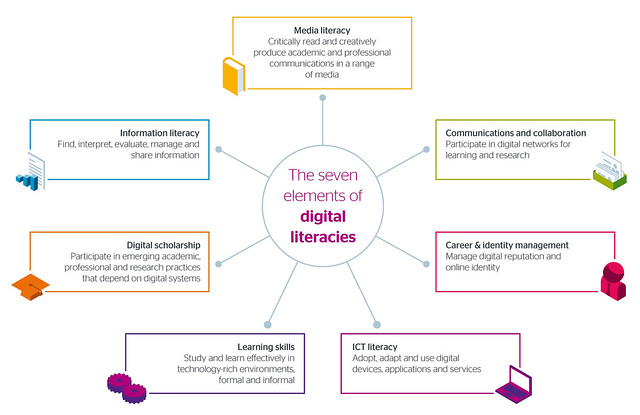You have /5 articles left.
Sign up for a free account or log in.
The seven elements of digital literacies model from Jisc represents a useful visual/model for those of us who teach, speak, and write about all things digital. When you think broadly about each of the 7 elements, connections can be made that resonate with student affairs work. The section on communications and collaboration is especially relevant for those of us who work to enhance student engagement and create opportunities for digital community.
The career and identity management element matches up perfectly to the concept of digital identity. When students transition into higher education it is often the case that their digital identity will also be in a state of transition. Career services and orientation programs are in the perfect spot for providing educational efforts on digital identity.
Information and communication technology (ICT) is perhaps the largest element in the model in terms of overall evolution and flux. Digital devices, applications, and services seem to change on a daily basis as "new" and "shiny" tend to dominate the news cycle. This is the digital literacy element that requires a good amount of experimentation, discovery, and dissonance.
Jisc, the UK's leading resource for digital solutions for education and research, provides a plethora of information on digital literacy on their web channels. According to Jisc, "digital literacy looks beyond functional IT skills to describe a richer set of digital behaviors, practices and identities."
Speaking of digital literacy/identity resources, a fantastic complement to the Jisc digital literacies model is David White's work on "visitors and residents." Breaking free from the all-too-rigid digital native/immigrant narrative, White writes about a "continuum of 'modes of engagement'" that embraces nuance and varying levels of digital fluency.
When we think about digital literacy, it is important to think broadly about the many aspects of all things digital. How we engage students, staff, and faculty via digital means requires a thorough understanding of our own digital identity. Working to enhance the digital literacy of students as well as faculty and staff is absolutely critical for digital engagement and identity.
You may have noticed that I shared two UK-based resources in this post. That is due to the fact that my wife and I recently moved to the UK. Getting plugged into UK higher education social media channels has been quite enlightening and informing. I'm looking forward to expanding the many resources that I share on a weekly basis on this blog and am excited to connect with the UK higher education community.
Do you tweet? Let's connect. Follow me on Twitter.
[Image credit] and here's a link to the full-size digital literacies image from Jisc.





